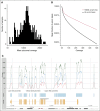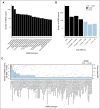A high-throughput sequencing test for diagnosing inherited bleeding, thrombotic, and platelet disorders
- PMID: 27084890
- PMCID: PMC5016734
- DOI: 10.1182/blood-2015-12-688267
A high-throughput sequencing test for diagnosing inherited bleeding, thrombotic, and platelet disorders
Abstract
Inherited bleeding, thrombotic, and platelet disorders (BPDs) are diseases that affect ∼300 individuals per million births. With the exception of hemophilia and von Willebrand disease patients, a molecular analysis for patients with a BPD is often unavailable. Many specialized tests are usually required to reach a putative diagnosis and they are typically performed in a step-wise manner to control costs. This approach causes delays and a conclusive molecular diagnosis is often never reached, which can compromise treatment and impede rapid identification of affected relatives. To address this unmet diagnostic need, we designed a high-throughput sequencing platform targeting 63 genes relevant for BPDs. The platform can call single nucleotide variants, short insertions/deletions, and large copy number variants (though not inversions) which are subjected to automated filtering for diagnostic prioritization, resulting in an average of 5.34 candidate variants per individual. We sequenced 159 and 137 samples, respectively, from cases with and without previously known causal variants. Among the latter group, 61 cases had clinical and laboratory phenotypes indicative of a particular molecular etiology, whereas the remainder had an a priori highly uncertain etiology. All previously detected variants were recapitulated and, when the etiology was suspected but unknown or uncertain, a molecular diagnosis was reached in 56 of 61 and only 8 of 76 cases, respectively. The latter category highlights the need for further research into novel causes of BPDs. The ThromboGenomics platform thus provides an affordable DNA-based test to diagnose patients suspected of having a known inherited BPD.
© 2016 by The American Society of Hematology.
Figures







Comment in
-
Platelet disorders: the next generation is in.Blood. 2016 Jun 9;127(23):2781-2. doi: 10.1182/blood-2016-04-703215. Blood. 2016. PMID: 27282940 Free PMC article.
References
-
- Ng PC, Kirkness EF. Whole genome sequencing. Methods Mol Biol. 2010;628:215–226. - PubMed
Publication types
MeSH terms
Grants and funding
- RP-PG-0310-1002/DH_/Department of Health/United Kingdom
- MR/K023489/1/MRC_/Medical Research Council/United Kingdom
- FS/09/039/27788/BHF_/British Heart Foundation/United Kingdom
- R01 HL094505/HL/NHLBI NIH HHS/United States
- R01 HL102482/HL/NHLBI NIH HHS/United States
- MR/J011711/1/MRC_/Medical Research Council/United Kingdom
- RG/09/012/28096/BHF_/British Heart Foundation/United Kingdom
- WT_/Wellcome Trust/United Kingdom
- P01 HL081588/HL/NHLBI NIH HHS/United States
- MR/L022982/1/MRC_/Medical Research Council/United Kingdom
- MC_PC_12009/MRC_/Medical Research Council/United Kingdom
LinkOut - more resources
Full Text Sources
Other Literature Sources
Medical
Miscellaneous

